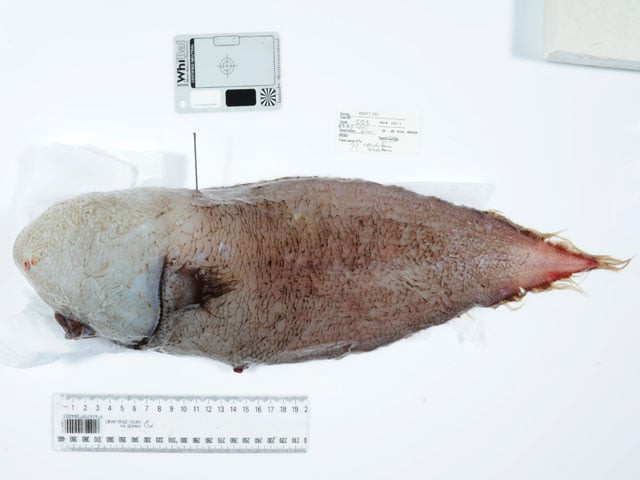Faceless fish among weird deep sea Australian finds
The fish and other wonderful creatures have been hauled up from the deep waters during a scientific voyage

This undated handout photograph received from Museums Victoria in Melbourne on May 31, 2017 shows a faceless fish, which has only been recorded once before by the pioneering scientific crew of HMS Challenger off Papua New Guinea in 1873. PHOTO: AFP
The month-long journey off the country's eastern seaboard has been surveying life lurking in a dark and cold abyss that plunges four kilometres (2.5 miles) below the surface, using nets, sonar and deep-sea cameras.
Chief scientist on board "The Investigator" Tim O'Hara from Museums Victoria said on Wednesday the search area was "the most unexplored environment on earth".
US scientists track fish migration using DNA in water samples
Bright red spiky rock crabs, puffed-up coffinfish, blind sea spiders and deep sea eels have been collected since the scientists began their voyage - from Launceston in Tasmania north towards the Coral Sea - on May 15.
They also came across an unusual faceless fish, which has only been recorded once before by the pioneering scientific crew of HMS Challenger off Papua New Guinea in 1873.
"It hasn't got any eyes or a visible nose and its mouth is underneath," O'Hara said from the ship.
 This undated handout photograph received from Museums Victoria in Melbourne on May 31, 2017 shows an abraliopsis, a member of the squid family, one of many species hauled up from the deep waters off Australia during a scientific voyage studying parts of the ocean never explored before. PHOTO: AFP
This undated handout photograph received from Museums Victoria in Melbourne on May 31, 2017 shows an abraliopsis, a member of the squid family, one of many species hauled up from the deep waters off Australia during a scientific voyage studying parts of the ocean never explored before. PHOTO: AFPAt such huge depths, it is so dark that creatures often have no eyes or produce their own light through bioluminescence, he added.
Another find was carnivorous sponges that wield lethal spicules made of silicon, effectively glass. They get small crustaceans hooked on their Velcro-like spines, to be slowly digested in-situ.
This technique differs from most deep-sea sponges, which feed on bacteria and other single-celled organisms filtered from passing currents.
"We've got 27 scientists on board who are leaders in their fields and they tell me that around one-third of what we've found are new species," said O'Hara, with several thousand specimens so far retrieved and two weeks of the trip still to go.
Life at such depths is one of crushing pressures, no light, little food and freezing temperatures, with animals that call it home evolving unique ways to survive.
Pakistani fish seller's song gets record deal with Warner Music
As food is scarce, they are usually small and move slowly. Many are jelly-like and spend their lives floating about, while others have ferocious spines and fangs and lie in wait until food comes to them.
Working in such an environment was challenging, O'Hara admitted, with each fishing expedition taking up to seven hours to deploy and retrieve the equipment and its eight kilometres of cable from the sea floor, given it is so far down.
But the data gathered was helping to improve the understanding of Australia's deep-sea habitats, their biodiversity and the ecological processes that sustain them, O'Hara said.
"This will assist in its conservation and management and help to protect it from the impacts of climate change, pollution and other human activity," he said.



















COMMENTS
Comments are moderated and generally will be posted if they are on-topic and not abusive.
For more information, please see our Comments FAQ